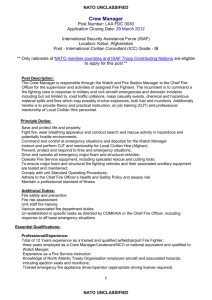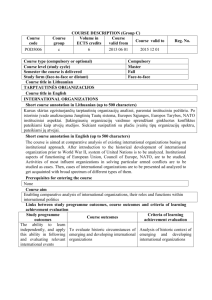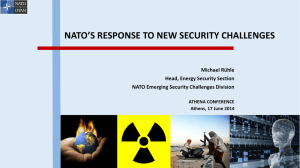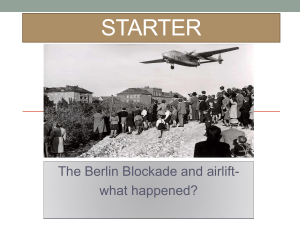DEFINING THE ENVIRONMENT - The Information Warfare Site
advertisement
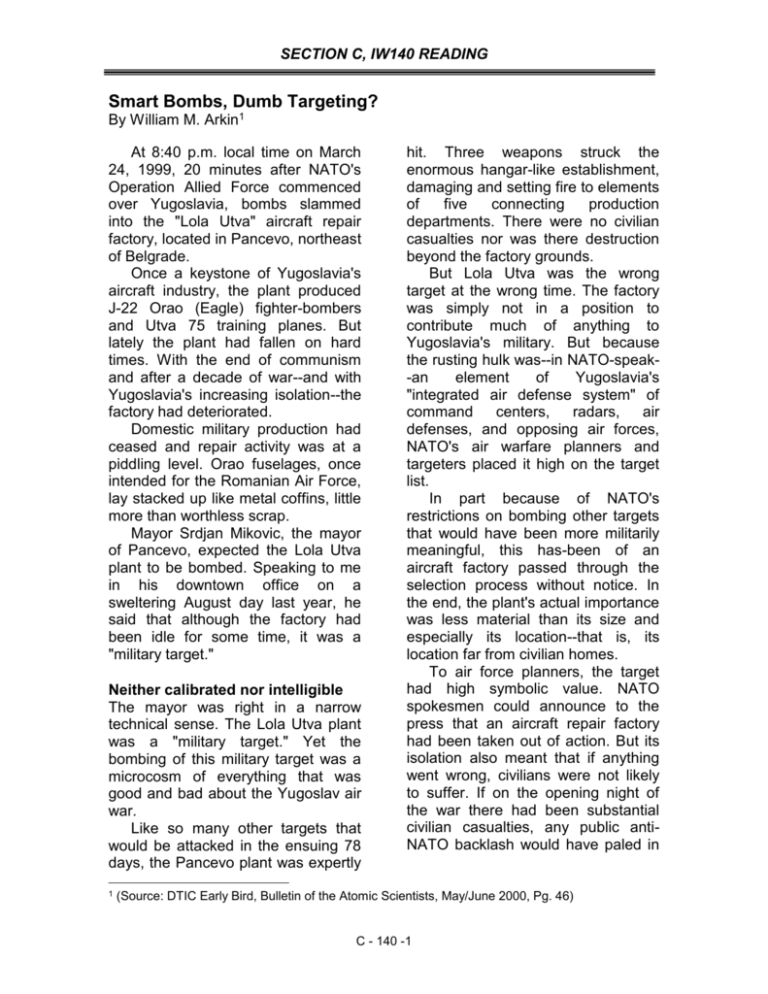
SECTION C, IW140 READING Smart Bombs, Dumb Targeting? By William M. Arkin1 At 8:40 p.m. local time on March 24, 1999, 20 minutes after NATO's Operation Allied Force commenced over Yugoslavia, bombs slammed into the "Lola Utva" aircraft repair factory, located in Pancevo, northeast of Belgrade. Once a keystone of Yugoslavia's aircraft industry, the plant produced J-22 Orao (Eagle) fighter-bombers and Utva 75 training planes. But lately the plant had fallen on hard times. With the end of communism and after a decade of war--and with Yugoslavia's increasing isolation--the factory had deteriorated. Domestic military production had ceased and repair activity was at a piddling level. Orao fuselages, once intended for the Romanian Air Force, lay stacked up like metal coffins, little more than worthless scrap. Mayor Srdjan Mikovic, the mayor of Pancevo, expected the Lola Utva plant to be bombed. Speaking to me in his downtown office on a sweltering August day last year, he said that although the factory had been idle for some time, it was a "military target." Neither calibrated nor intelligible The mayor was right in a narrow technical sense. The Lola Utva plant was a "military target." Yet the bombing of this military target was a microcosm of everything that was good and bad about the Yugoslav air war. Like so many other targets that would be attacked in the ensuing 78 days, the Pancevo plant was expertly 1 hit. Three weapons struck the enormous hangar-like establishment, damaging and setting fire to elements of five connecting production departments. There were no civilian casualties nor was there destruction beyond the factory grounds. But Lola Utva was the wrong target at the wrong time. The factory was simply not in a position to contribute much of anything to Yugoslavia's military. But because the rusting hulk was--in NATO-speak-an element of Yugoslavia's "integrated air defense system" of command centers, radars, air defenses, and opposing air forces, NATO's air warfare planners and targeters placed it high on the target list. In part because of NATO's restrictions on bombing other targets that would have been more militarily meaningful, this has-been of an aircraft factory passed through the selection process without notice. In the end, the plant's actual importance was less material than its size and especially its location--that is, its location far from civilian homes. To air force planners, the target had high symbolic value. NATO spokesmen could announce to the press that an aircraft repair factory had been taken out of action. But its isolation also meant that if anything went wrong, civilians were not likely to suffer. If on the opening night of the war there had been substantial civilian casualties, any public antiNATO backlash would have paled in (Source: DTIC Early Bird, Bulletin of the Atomic Scientists, May/June 2000, Pg. 46) C - 140 -1 SECTION C, IW140 READING comparison with the internal alliance convulsions. The Lola Utva aircraft repair factory was not unique. Over the course of the war, dozens of other factories, transmitters, bridges, and power stations were selected to be hit in an equally mechanical process of meticulous selection with little true military justification. NATO Secretary-General Lord Robertson claimed in March during the one-year anniversary of Allied Force that the air campaign had been a "careful operation" calibrated to attack "proportionately and appropriately." But little about the bombing campaign suggests that there was even the slightest understanding of what "appropriate" air war targets really are. Allied Force was neither calibrated nor intelligible. Rather, it was a succession of unfocused and unconvincing air excursions-experiments in communication by detonation. Poorly designed This piece is not about the nature of the Yugoslav regime or the war's various political purposes and ramifications. Nor is it about the fine points of international law regarding intervention, a profoundly complex issue. It is simply about an aspect of air power, as applied over Yugoslavia, Iraq, or elsewhere: targeting. Last August, I led a bomb damage assessment mission to Yugoslavia under the auspices of Human Rights Watch. That was less than two months after the end of the war. Our team inspected more than 250 targets, reported targets, and locations where there had been civilian casualties or damage to civilian structures. Although I admit to being an admirer of the precision application of air power, the picture on the ground was not encouraging. The execution of the NATO air war defied simple analysis. Our damage assessment once again contradicted the conventional wisdom that bombing is, by its nature, indiscriminate and immoral. But the design of the air campaign also offered little comfort to air power zealots, who often argue that air warriors, especially in the United States, have it all figured out--that they know just what to do with their smart weapons. In fact, the most worrisome observation was that the very people who made the decision to go to war and who thus laid out the objectives for the air campaign did not seem to really understand their opponent. In particular, they were too hesitant to employ military force effectively after they had made the decision to use force. And once the decision was made to use force, the air war sorely needed a military and targeting strategy to match its technology. Beyond the specifics of the NATO war, it is also clear that air war itself needs an accepted doctrine to guide those in the future who would rely upon the military as a last-ditch means of resolving the world's problems. The meaning of accuracy Having spent considerable time surveying post-war bomb damage in Iraq after the end of the Gulf War, I C - 140 -2 SECTION C, IW140 READING found nothing particularly noteworthy about the physical destruction in Yugoslavia. In the context of the 1990s, Allied Force was just another precision war. Some 28,000 weapons were dropped, 29 percent of which were "smart" weapons. (In the Gulf War, it was 9 percent.) But one has to be on the ground to truly appreciate both the extraordinary precision of modern weapons and the emptiness of current U.S./NATO air war dogma. Because of precision, post-conflict evaluation can be fine art, at least when conducted on the ground. Specific targets are separable and obvious. Individual injuries can be inspected and something as minor as broken windows are noteworthy. In a peculiar way, that is a heavy burden for a mode of warfare that has demonstrated the potential to be so much less destructive and deadly than old-style bombing, in which whole neighborhoods might be leveled to take out a bridge or a factory or a rail yard. But today, when weapons can be targeted so precisely, every weapon counts. Targets have to be meticulously chosen and the choreography of a conflict becomes ever more essential. In the new American style of air warfare, the effects of bombing are no longer firestorms and widespread rubble, as was true in World War II, Korea, and Vietnam. In those wars, precision was often the aim but seldom the outcome. Civilian casualties were awesomely high. Today, most targets are seen as parts of networks. Meaningful effects are measured not in terms of physical destruction but according to systemic (or functional) impact. At least, that's the theory. Where today's air warriors fail is in their often-made claim that they already understand these strategic effects and can predict the impact systemic attacks will have on enemy militaries and decision-makers. Another thing that is clear from the ground is that the colloquial understanding of "accuracy" differs greatly from the meaning of accuracy within military and intelligence circles. Internal Pentagon documents show that for all weapons--smart and dumb--only 58 percent of the intended "aimpoints" were hit. The U.S. Air Force used 5,285 precisionguided weapons, which represented 78 percent of all the smart weapons employed by NATO. Of that number, 70 percent hit their aimpoints. To most people, that suggests that 30 percent of the precision weapons missed their targets, a suggestively tragic number with high civilian loss as the imagined byproduct. But the accuracy standard applied by the military is so extraordinarily strict that civilians are seldom put at risk, assuming that the target was properly selected in the first place. An aimpoint might be, for instance, the center of Hall Three of the Lola Utva factory. If the weapon lands 500 feet away on Hall One, it is said to be a miss. When the object of an attack is a tank, a bridge, or a transmission tower--or when civilians are within the danger zone--such accuracy matters a great deal. But in most cases, the level of accuracy is so much greater today than ever before that a "miss" hardly ever means that civilians will be harmed. C - 140 -3 SECTION C, IW140 READING But that is not the way the public, the press, or even military spokespersons seem to understand it. To the public and the press, a "miss" strongly suggests an unfortunate and brutally bad outcome. To the military, a miss simply means failure. Neither assumption is necessarily true. To be sure, errant bombs and shrapnel caused civilian casualties in Yugoslavia. Out of 10,000 strikes, there were 90 incidents in which civilians were killed because of technical failures, or because they were too close to military targets, or because of errors in judgment by pilots or targeters. In all, there were some 500 civilian deaths and a few hundred injuries from the bombing. What won the war? There were about 900 targets of all types in Operation Allied Force, which included some 9,800 aimpoints. About 400 of these targets were fixed structures spread out over Serbia, Kosovo, and Montenegro, the majority being in Serbia. About 3,000-5,000 weapons fell in all of Serbia; most of the rest were dropped in Kosovo. Of these, the majority were aimed at large airfields, barracks, and factories. Of the 350 or so strategic targets in Serbia, precision weapons were almost exclusively used, and they were delivered in small numbers per mission. Competing post-war arguments have been made about which NATO actions "won" the war. Strikes in Kosovo and the "threat" of a ground war were decisive according to a host of analysts. No, others say, strategic attacks on civilian-morale targets, such as electricity and media outlets, carried the day. Still others emphasize so-called "crony attacks," which affected the economic interests of Slobodan Milosevic and his leadership. We may never know what drove Milosevic to finally accede to NATO's demands. But promiscuous claims about what ended the war can only have the effect of sowing confusion about air power and shielding air warriors from the need to develop finer and more coherent targeting doctrines. But even if we cannot answer the question as to what finally persuaded Milosevic to give in, we can examine what was bombed and when, and what the effects were. Those answers are central to the further development of modern air war strategy. "Crony" targeting If there was anything distinct about the target selection process, it was NATO's strategy to pressure insider "cronies" to force Milosevic to end the war, because their economic interests were being damaged. That strategy was partly the result of NATO's self-imposed constraints. When Allied Force began, a variety of possible targets--including electricity, media facilities, and certain dual-use industries--were put off limits because they were largely "civilian" targets. Yet it took all of a day or two before NATO governments began "escalating" and considering them to be additional target categories. Soon enough, downtown Belgrade, bridges in the north, civilian factories, radio and television transmitters, electrical transformers, C - 140 -4 SECTION C, IW140 READING and the like were added despite earlier "legal" and policy objections. About a month into the air war, U.S. planners and their British counterparts began to consider what they simply called "the strategic campaign plan." Targeting officers called it the "3M" strategy--money, MUP (Ministry of Interior), and media. Covert operations, psychological warfare, information operations, and bombing would be coordinated to threaten what air war planners labeled Yugoslavia's "centers of gravity." Regardless of what one thinks about the 3M strategy, that it took a month for it to emerge was scandalous. It should not be surprising that when the press finally reported on the secret scheme in April--quickly dubbing it "crony targeting"--it was not applauded as a clever new strategy. It merely became another source of friction for the alliance as the news media began to report attacks on civilian installations whose only relevance seemed to be to put pressure on the business elite. While NATO leaders and planners may have believed that they were communicating some sort of message to Milosevic through bombing, on the ground the message could hardly be extracted from the background noise. Consider the bombing of the Sloboda factory in Cacak, hit on the first night of the war. The factory was carried on the master target list as the "Cacak Ammunition Plant Sloboda," responsible for manufacturing ammunition casings and components. Because of its military function, targeters later said that the factory would have been bombed regardless of any later scheme. But hitting the plant was also seen by the targeting group as a useful testing of the waters, to see what allied reaction would be to the bombing of a "dual use" factory--that is, a plant that also made consumer goods. That included vacuum cleaners, which some in the press seemed to delight in reporting. Nevertheless, the negative reaction inside the alliance was muted. By the time the Smederevo steel plant and the Bor copper smelter were bombed in mid-May--as true crony targets--did anyone know that they were specifically selected as part of the 3M strategy? I doubt it. Fragile grids The NATO planners went to great lengths to safeguard the civilian population. Nowhere was this clearer than in the bombing of Yugoslavia's electrical power systems. Traditionally, "energy" installations have been regarded as legitimate targets, as long as--according to the guidelines of the International Committee for the Red Cross--the electricity from individual plants is used "mainly for military consumption." But that is not the way the world works these days. Most modern countries, including Iraq and Yugoslavia, have integrated national power grids. Individual installations are not dedicated to military production. To have an effect, large segments of the entire network need to be attacked, directly shutting down the power supply or so stressing the C - 140 -5 SECTION C, IW140 READING system that nodes in the network can't pick up the slack and a general black-out is induced. In the Gulf War, attacks on the grid included attacks on expensive and difficult to repair electrical generators. Because generating capacity was damaged, Iraq was not able to quickly recover. This led to significant civilian suffering and many postwar civilian deaths. Nevertheless, electricity remains an attractive target. Grids are fragile. With only a few choice bombs, air force dogma holds, it is possible to compromise air defenses, commandand-control systems, and communication systems, even if the other side has back-up generators. The fragility of modern electrical networks and the need to avoid longlasting civilian harm have inspired the development of new weapons and tactics. In Allied Force, the extraordinary weapon used for this purpose was the CBU-102 (V) 2/B, a system developed in great secrecy during the 1990s. Each CBU-102 contains 202 submunitions within what is essentially a standard cluster bomb body. Each bomblet is stuffed with 147 tiny spools of glass-like and highly conductive aluminum fibers. Each spool unwinds to a length of 150 meters. The thread itself consists of some 30 filaments finer than human hair. Every bomblet contains four-anda-half kilometers of fibers. A single bomb dropped on an outdoor transformer station dispenses a spidery latticework adding up to more than 900 kilometers of threads, the distance from Washington to a point somewhere in the woods north of Montreal. When the threads come in contact with power lines or energized equipment, they cause shorts and trip protective devices, resulting in partial or complete blackouts. On May 2, aircraft dropped these weapons on five Yugoslav transformer stations, causing an almost complete collapse of the central Serbian power system. "We regret the inconvenience that power outages have caused to the Serb people," said NATO spokesman Jamie Shea. Nonsense. The whole point of turning off the lights on May 2 was to bring the war home to the Yugoslav people by causing quite a lot of "inconvenience." During the planning for Operation Allied Force, air force targeters argued to no avail for electricity to be hit early on--for military purposes, not psychological effects. "Shutting down electricity," one senior officer told me, "along with the distribution elements of POL [petroleum, oil, and lubricants] can impose paralysis on the regime rapidly by stressing power supplies for things like communications systems, air defenses, transportation, TV, and radio." When the decision was finally taken a month into the war to attack the grid as an escalation step, any military effect was purely coincidental by then. The morning after the initial attacks, Yugoslav workers began to remove the threads, using poles and tree branches and eventually industrial cherry pickers. At Obrenovac south of Belgrade, Yugoslavia's largest power plant, it took some 500 people 15 hours to C - 140 -6 SECTION C, IW140 READING clear the threads sufficiently to restart equipment. The CBU-102s were employed again on May 8 to again shut down the grid. By then, response time had improved to as little as four hours. So NATO then decided to bomb stations with laser-guided "hard" bombs, disabling long-distance power lines, transformers, and distribution nodes. Seventy percent of Serbia's electrical power went down on May 22. The new weapons worked. Inside the air force and elsewhere, many analysts argue that the loss of electrical power had such an impact on civilian morale in Belgrade and elsewhere that it was the "most important" target group to be attacked. That could be true. But it is an assumption. We do not know it to be true from the evidence. Nor do we yet know whether in the future electricity can indeed be bombed in a way that would have a strictly military effect, sparing civilians from undue hardship, illness, and even death. The head of the snake Speaking in March at the International Institute for Strategic Studies in London at the one-year anniversary of Allied Force, Lord Robertson told his listeners that NATO was "absolutely right" to go to war and to act when and how it did. "It may not surprise you that I am saying this, but frankly, it surprises me that I have to keep repeating it." If NATO and U.S. officials seem defensive in their victory, one of the reasons is that criticism of the war touches on fundamental points. And the criticism has not been limited to outsiders. Partisans of air warfare-including officers in NATO--have spent a year carefully disassociating themselves from the design of the NATO campaign. "I'd have gone for the head of the snake on the first night," Lt. Gen. Michael Short, the NATO air war commander, told Congress in October. "I'd have turned the lights out . . . dropped the bridges across the Danube . . . hit five or six politicalmilitary headquarters in downtown Belgrade," he added. "Milosevic and his cronies would have woken up the first morning asking what the hell was going on." Military insiders blame the "ABC" clique of Secretary of State Madeleine Albright, National Security Adviser Sandy Berger, and U.S. Army Gen. Wesley Clark, overall commander of Allied Force, for denying them (and NATO) a sensible military plan. Civilian damage limitations and interference, inadequate intelligence, unprepared allies, a broken "joint" system of warfare, have all been derided as impeding an idealized air war strategy. General Short was particularly disparaging of the French for opposing early attacks on electricity and on civilian media. Short and his colleagues have focused blame everywhere but on the U.S. Air Force itself. General Short and others may have wished for the freedom to replay the Gulf War, in which more targets were hit harder and more quickly. But the truth about Operation Allied Force is that U.S. air warriors could not make a compelling enough case for their preferred air strategy, either C - 140 -7 SECTION C, IW140 READING internally within the U.S. military or with political leaders. In the end, it is not clear that the model of air warfare used in Iraq is either repeatable or universal. Nor is it clear that precision destruction of the fabric of modern society is indeed a lawful or even a militarily superior approach. Only institutional pride would maintain that there is only one formula for subduing an enemy. A high obligation Still, for all the criticism of targeting, Allied Force was fought with the utmost concern for civilian casualties and damage. A greater percentage of smart weapons was used than in any other conflict in history. Targeting was more scrutinized and micromanaged at the civilian level than at any time since Vietnam. Enormous efforts were made, largely successful, to avoid short- and long-term civilian casualties. When mistakes or complaints did occur in the 78 days of bombing, changes were implemented and many unpublicized restrictions were levied. Together, these constitute a rich fabric of operational history, one that cries out for greater airing. That the French and other allies may have been right in their opposition to U.S. targeting dogma is another important facet, yet one that seems lost in U.S.British defensiveness. The era of smart weapons is here. Yet we do not seem to be as smart as our weapons. We have gotten to the point where civilian harm as we traditionally have come to see it is indeed minimized. Meanwhile, military doctrine, targeting, and the new fangled information warfare, is focusing more and more on societal and systemic nodes for attacks, potentially eroding the law of war principle that says attacks must be directed against only military targets, not civilian life. When air power is used--as it was in Yugoslavia--to halt a humanitarian disaster, there is a high moral obligation to use force in a way that not only preserves civilian life but ends the conflict as rapidly as possible. It is not certain that the NATO air campaign met that standard. Contrary to the views of many political decision-makers, some warfighters, and most air-power critics, if NATO had taken greater risks in Yugoslavia--hitting harder and faster--it might have shortened the war while not putting the citizens of Yugoslavia at greater risk. This is not to suggest that Gen. Short's cut-off-the-head-of-the-snake way of doing it would have been ideal, or that the special 3M strategy was completely misguided, or even that the mindless selection of targets like electrical power grids and the Lola Utva aircraft factory in Pancevo were completely off base. Rather, I suggest that the air warriors do not yet have the definitive answers and that the operational history of the NATO war only provides clues. The Yugoslavia campaign does not support any one model for air power in the future, and it is dangerous to think it does. Bill Arkin, a senior military adviser to Human Rights Watch, has conducted on-the-ground air warfare bomb damage assessments in Iraq, Lebanon, and Yugoslavia. The views expressed are his own. C - 140 -8 SECTION C, IW140 READING Speeding Up the Flow Instantaneous Attack Capability Near For U.S. Continuous Surveillance Gives Leaders, Pilots Immediate Picture By Frank Tiboni, Washington Afghanistan’s most important military lesson is that the United States can monitor the battlefield for long periods of time, sending a continuous flow of information to air, space and ground weapon systems, say senior Pentagon officials. For the first time in combat, live imagery flew from Predator unmanned aerial vehicles (UAVs) to U.S. F-16 fighters, AC-130 gunships and F/A-18 strike fighters, allowing them to attack Taliban and al-Qaeda targets almost immediately. Meanwhile, E-8, RC-135 and E-3 surveillance aircraft and the developmental Global Hawk UAV continued to scrutinize the battlefield, constantly updating the picture for searchers, troops and decisionmakers. The Pentagon’s chief information officer calls this persistent ISR intelligence, surveillance and reconnaissance - and hails it as a significant step forward in the Pentagon’s information gathering capabilities. "We are taking what is, in effect, television pictures and staring at the same place and deciding where to move the camera based on what we see," John Stenbit, assistant secretary of defense, command, control, communications and intelligence, told Defense News Dec. 18. The military services’ ability to quickly gather and distribute information has come far in the past decade, officials say. During the 1991 Persian Gulf War, it took hours to get a Pioneer UAV over an area of interest, and hours, even days, more to get the information to commanders and troops, Stenbit said. By 1999’s Operation Allied Force in Kosovo, the Pentagon had added the Hunter and Predator UAVs, but the information still was not flowing quickly to those who needed it, he said. Although UAVs provided continuous coverage of critical targets in Kosovo, the U.S. military recognized that UAV operations needed to be better integrated into overall campaign plans, according to a January 2000 report to Congress, "Kosovo/Allied Force After Action Report." Pentagon analysts listed some of the problems that needed fixing: streamlining the targeting process; increasing the number of ISR assets in a theater; and rapidly finding and destroying mobile targets in poor weather and dense foliage. "Persistent ISR is letting us find a target in Afghanistan, combine it with a weapon, shoot a weapon and watch what happens," said Stenbit. "If we see that they try to escape in that truck, we can then shoot that truck." Sending live video from UAV sensors to fighter cockpits is one of the biggest recent changes in the way the U.S. fights its wars, said an industry intelligence analyst. "There were regular complaints in the Gulf War of imagery not moving. In C - 140 -9 SECTION C, IW140 READING some cases, imagery was not getting in the hands of our military leaders. And if it was, it was days old. Whatever was wrong has been corrected in large part," Steven Aftergood, a senior research intelligence analyst for the Washington-based watchdog Federation of American Scientists, told Defense News Jan. 4. The new UAVs’ ability to loiter for hours over a battlefield is the main reason this became possible, said retired Air Force Gen. Richard Hawley, former commander of Air Combat Command. "Persistent ISR is a concept that has arisen solely because of the ability of a UAV to stay on station for very long periods of time," Hawley told Defense News Jan. 4. Several years after Kosovo, Air Force Secretary James Roche says Operation Enduring Freedom in Afghanistan is proving that persistent ISR is moving the U.S. military a step closer to its long-sought goal of timecritical targeting. "We are heading toward a goal of instantaneous attack. I think we’re almost there," said Roche in a Dec. 21 interview. "Once the commander says that it’s a legitimate target, we want to be able to attack now. Not three hours from now." Roche praised the flexibility of operation commander Army Gen. Tommy Franks, commander in chief of U.S. Central Command, MacDill Air Force Base, Fla., who allowed the Air Force to experiment with its young weapon systems. "We are now learning an enormous amount by having all these systems in there," Roche said. Persistent ISR is not just about finding and engaging targets quickly. It is also about receiving a constant picture of a region in order to make sure troops know where to camp and how the enemy is arranged, said an Air Force official. "The only way to make sure you didn’t miss anything is to have an eyeball on it all the time," the official said. Even more important is making it easier for personnel to decipher what it all means. "The real key to persistent ISR is assessing the battlefield before the fight begins," a congressional analyst told Defense News Jan. 3. The Air Force will use these lessons to try and develop a multisensor command-and-control system within the decade, Roche said. The system would tie together manned and unmanned sensors in the air, on the ground and in space, allowing it to focus on an area with pinpoint accuracy continuously in all weather conditions, he said. "We’re using up enormous bandwidth," said Roche. "If we’re going to try to do 24-7, we need a portfolio of sensors because no one [sensor] is going to do it," Roche said. Gail Kaufman contributed to this report. C - 140 -10



